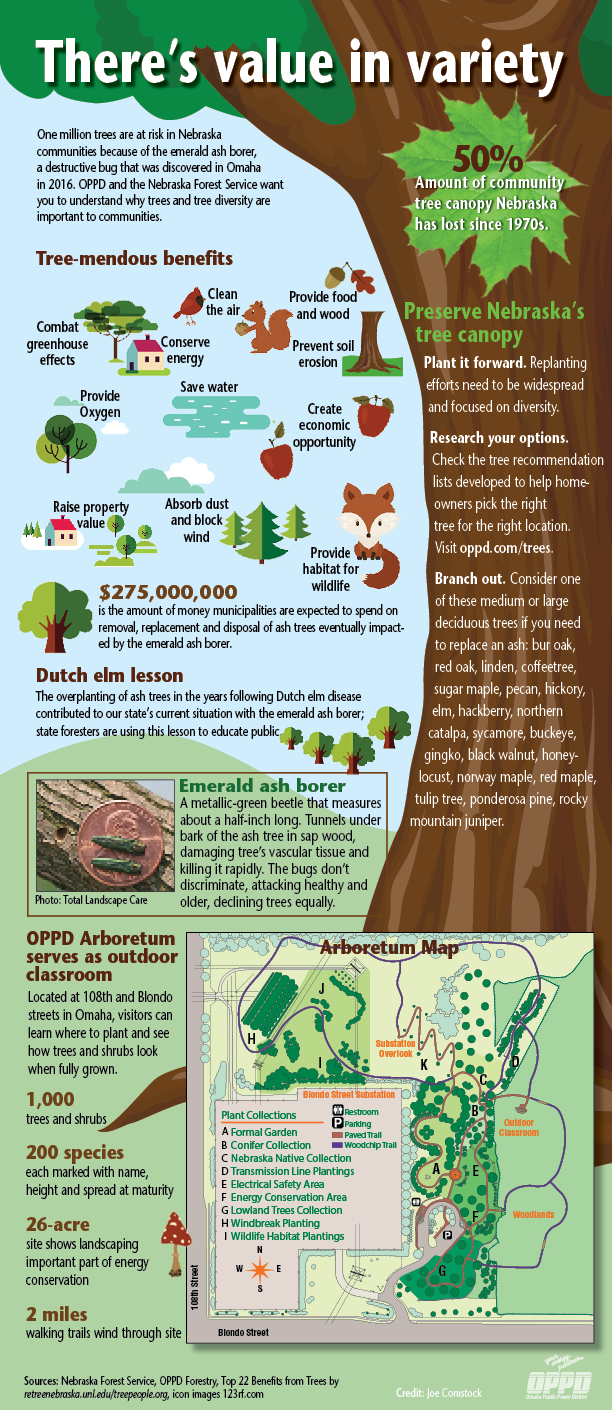
It’s just a matter of time before the emerald ash borer (EAB) dramatically reduces Nebraska’s ash tree population.
EAB infestations typically kill about 70 percent of unprotected ash trees within four years. The destructive insect was first spotted here in 2016. If patterns seen in other states hold true, within 15 years, nearly 100 percent of untreated ash trees could be lost.
That’s significant when you consider ash trees make up about 15 percent of Nebraska’s total tree canopy. In some communities, ash trees make up as much as 40 percent of public tree cover.
learning from the past
The fast-growing, generally hearty species was overplanted to replace elm trees lost to Dutch elm disease. In the past 30 years, the Nebraska Forest Service reports Nebraska has lost about half of the state’s tree population.
Tree experts like OPPD Utility Forester Mike Norris say we should learn from past mistakes.
“Planting too many of one type of tree puts us at risk of losing a significant portion of our tree cover when new threats reach our area, and they will.”
think variety
The ReTree Nebraska: plant it forward campaign is working to get the word out about the importance of planting more trees with greater variety.
Norris urges thoughtfulness when selecting trees for our yards. Beyond variety, also think about energy savings and electric service reliability.
“Utility foresters work to educate the public on planting the right tree in the right location. Properly planted trees provide wind breaks during the winter to help keep homes warmer, and shade during the summer to help keep them cooler.”
He added, “We urge our customers to avoid planting trees near power lines. At the very least, make sure you know what the tree’s mature height will be, and that it won’t grow tall enough to touch power lines.”
community effort
OPPD foresters have identified 10,000 ash trees in proximity of power lines within the district’s service territory. They urge tree owners to either treat the tree to prevent an infestation, or have a tree care professional safely remove it.
“If those trees are not treated and left where they are, they will likely come crashing down at some point on power lines or other property,” Norris said. “It’s a big safety issue. You don’t want to take that risk.”
For help with EAB-related issues, contact an arborist in your area.
The following infographic shows the value in planting different types of trees.

Jodi Baker contributes stories to The Wire in addition to serving as a media liaison for OPPD. She was a reporter, working for news stations from her hometown of Omaha to San Diego, prior to joining the utility in 2013. Jodi has a bachelor’s degree in Broadcasting from the University of Nebraska-Omaha, with a minor in Criminal Justice. She’s married with two older children and two younger dogs – Shi Tzu mixes. She loves watching her daughter’s track meets, going to concerts with her husband Dave, who used to co-host a local music video program, and traveling whenever possible.
View all posts by Jodi Baker >








